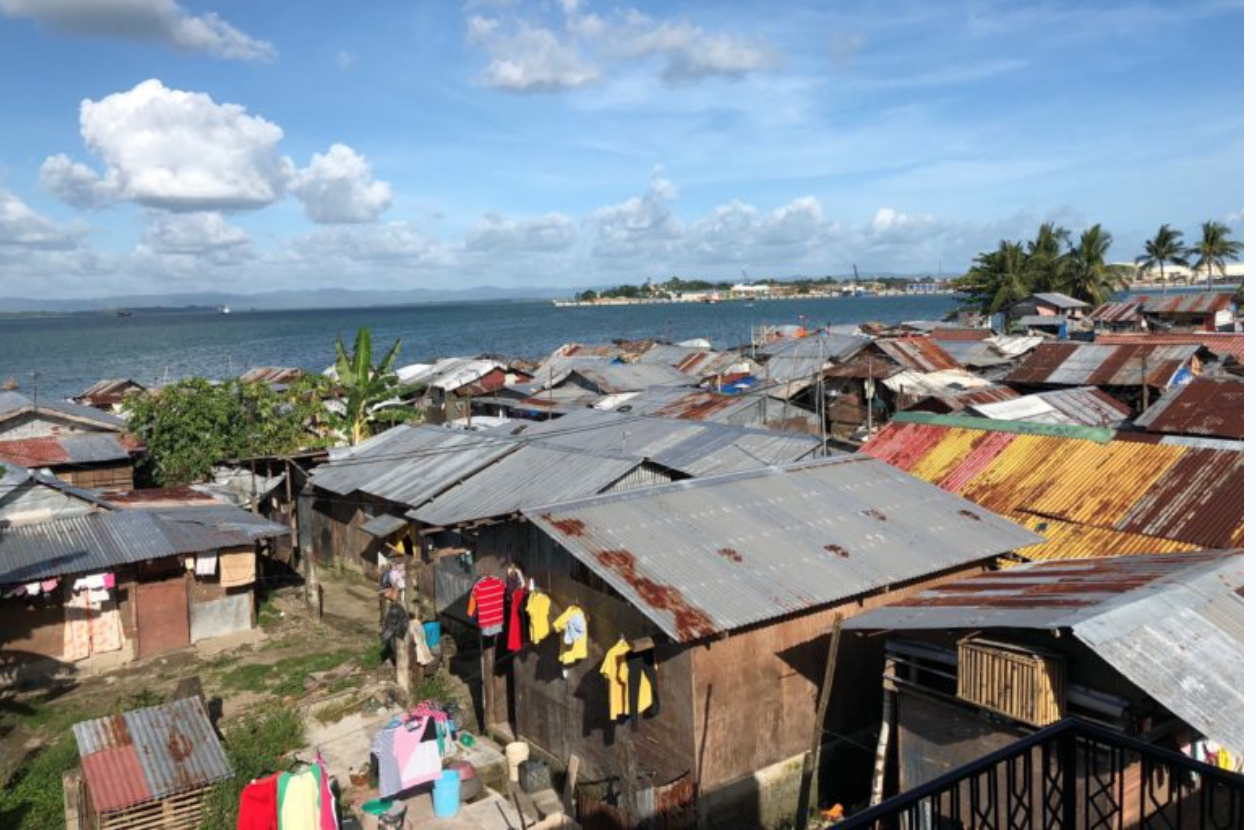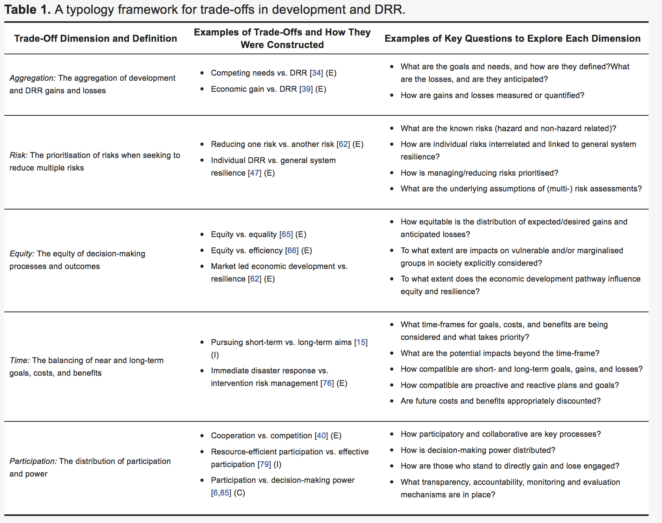A typology framework for trade-offs in development and disaster risk reduction: a case study of Typhoon Haiyan recovery in Tacloban, Philippines

Summary
This paper* presents, explores, and tests a conceptual framework for analysing the trade-offs that underpin this relationship as evidenced through policy goals, initiatives, and decision-making processes.
In the paper we categorise key dimensions of relevant trade-offs into five specific dimensions: (i) The aggregation of development and DRR gains and losses, (ii) risk prioritisation when seeking to reduce multiple risks, (iii) the equity of decision-making processes and outcomes, (iv) the balancing of near- and long-term goals, and (v) the distribution of power and participation. By framing key questions related to each trade-off dimension, we test the framework in the context of a major disaster recovery process in Tacloban, the Philippines, following Typhoon Haiyan (Yolanda) in November 2013. We consider how decision-making trade-offs can be made more visible and useful in the pursuit of transformative change in development and DRR.
This paper was originally published in Sustainability on 8 June 2018.
*Download this open access journal article from the right-hand column or via the links below. Some key messages extracted from the paper are provided below. See the full text for much more detail.
Methods and Tools

First, we conducted a non-systematic review of scientific literature, grey literature, and policy and planning documents relevant to development and DRR. The review assessed the extent to which the literature considers trade-offs, and the typology framework was developed from explicit, implicit, and constructed considerations and examples of trade-offs. Explicit trade-offs used the term ‘trade-off’ to describe two issues that represented misalignment between development and DRR.
Second, we tested the trade-off typology framework in a post-disaster (Typhoon Haiyan/Yolanda) recovery and redevelopment context in Tacloban City, Philippines. The testing sought to validate the framework by gathering empirical evidence on the decision-making processes directly related to post-disaster recovery and redevelopment efforts at the city level. We conducted two rounds of semi-structured key-informant interviews in 2017 with representatives from: (i) National, regional, city-, and local-level government offices; (ii) INGOs, NGOs, and intergovernmental organisations ; and (iii) homeowners associations and residents in the resettled areas. The first round of interviews gathered data on the decision-making and planning process, the second round on project implementation, monitoring, and evaluation. A total of 41 interviews were conducted. Better understanding of the trade-offs between development and DRR goals, initiatives, and decision-making processes offers potential to advance mutually desirable development and DRR outcomes of equity, resilience, and sustainability. Here, we present a typology to unpack trade-offs, organised along five key dimensions: Aggregation, risk, equity, time, and participation. Each trade-off dimension can be further explored by posing and responding to key questions that reflect the interlinked nature of the trade-off dimensions (see Table 1). By first identifying the aggregated gains and losses resulting from decisions and interventions, one can discern: (i) How those gains, losses, and related risks are accounted for and distributed spatially, temporally, and across social groups, and (ii) the distribution of power and participation in the decision-making processes from which the gains and losses are constructed and evaluated.Lessons Learnt
The presented and tested typology framework aims to identify and articulate potential development–DRR trade-offs inherent in decision-making processes, ideally, before they take place. We argue that:
- identifying and making trade-offs, explicit from the outset, represents the first steps towards addressing these issues in decision-making and in transforming the relationship between development and DRR;
- Recognising trade-offs may or may not lead to a decrease in the competition among various goals or the elimination of trade-offs;
- identifying trade-offs and exploring the potential consequences of different possible decisions gives a better understanding of how risk is created.
- this can lead to appropriate solutions to be deliberated amongst stakeholders for more equitable, resilient, and sustainable outcomes, thus, transforming the relationship between development and DRR .
Conclusions
Development continues to be an underlying driver of disaster risk despite increased recognition of this fact. The trade-off typology framework presented in this paper is a first attempt to organize and examine the various trade-offs that exist between development and DRR. The typology provides a framework through which five dimensions of trade-offs in decision-making can be examined, including aggregation, risk, equity, time, and participation. We tested this framework in Tacloban, Philippines, following Typhoon Haiyan (Yolanda), to understand the decision-making trade-offs in a major disaster recovery process. We highlight the need to better understand and address the inherent trade-offs in decision-making, which involves looking deeper into how decisions are made at all levels and to what extent decision-making goals and processes at all levels align. Focusing on trade-offs moves interventions to reduce disaster risk upstream to the processes and inherent decisions which shape development and regulation. It acknowledges that disaster risk is created by those processes. Focusing on the trade-offs faced by decision-makers at all levels can, thus, help to identify a space for policy- or decision-making for a pro-active, rather than reactive, approach to DRR.Suggested citation:
Tuhkanen, H.; Boyland, M.; Han, G.; Patel, A.; Johnson, K.; Rosemarin, A.; Lim Mangada, L. A Typology Framework for Trade-Offs in Development and Disaster Risk Reduction: A Case Study of Typhoon Haiyan Recovery in Tacloban, Philippines. Sustainability 2018, 10, 1924. DOI: https://doi.org/10.3390/su10061924
(0) Comments
There is no content